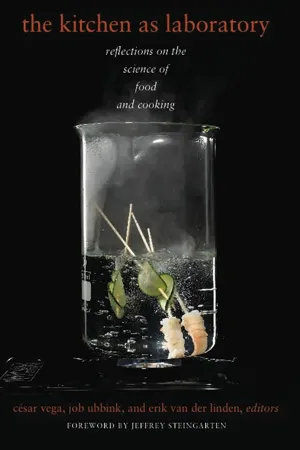
The Kitchen as Laboratory
Reflections on the Science of Food and Cooking
- 338 pages
- English
- ePUB (mobile friendly)
- Available on iOS & Android
The Kitchen as Laboratory
Reflections on the Science of Food and Cooking
About This Book
"Provides good perspective on the scientific approach to cooking while reflecting the interests and passions of each essay's author."—Peter Barham, author of The Science of Cooking
In this global collaboration of essays, chefs and scientists advance culinary knowledge by testing hypotheses rooted in the physical and chemical properties of food. Using traditional and cutting-edge tools, ingredients, and techniques, these pioneers create, and sometimes revamp, dishes that respond to specific desires and serve up an original encounter with gastronomic practice. From the seemingly mundane to the food fantastic—from grilled cheese sandwiches, pizzas, and soft-boiled eggs to Turkish ice cream, sugar glasses, and jellified beads—the essays in The Kitchen as Laboratory cover a range of creations and their history and culture. This collection will delight experts and amateurs alike, especially as restaurants rely more on science-based cooking and recreational cooks increasingly explore the physics and chemistry behind their art. Contributors end each essay with their personal thoughts on food, cooking, and science, offering rare insight into a professional's passion for playing with food.
"Where else can one have fun pondering the acoustics of crunchy foods or the texture of an ice cream that stretches like a rubber band?"—Robert Wolke, author of What Einstein Told His Cook: Kitchen Science Explained
"Not only an in-depth study of many areas of food science, but also an entertaining read. For someone like me, who relishes understanding more about cooking from the inside out, it's heartening to see this area of literature expanded."—Chef Wylie Dufresne, wd~50
Frequently asked questions
Information
Table of contents
- Cover
- Title Page
- Contents
- Copyright
- Foreword by Jeffrey Steingarten
- Acknowledgments
- Introduction: The Case for Science Inspired by the Kitchen
- 1. The Science of a Grilled Cheese Sandwich
- 2. Sound Appeal
- 3. Mediterranean Sponge Cake
- 4. Spherification: Vaux Caviar and Skinless Ravioli
- 5. Konjac Dondurma: Designing a Sustainable and Stretchable “Fox Testicle” Ice Cream
- 6. Stretchy Textures in the Kitchen: Insights from Salep Dondurma
- 7. Moussaka as an Introduction to Food Chemistry
- 8. The Sticky Science of Malaysian Dodol
- 9. The Perfect Cookie Dough
- 10. To Bloom or Not to Bloom?
- 11. Bacon: The Slice of Life
- 12. Scandinavian “Sushi”: The Raw Story
- 13. Maximizing Food Flavor by Speeding Up the Maillard Reaction
- 14. Lighten Up! The Role of Gases in the Culinary Experience
- 15. The Meringue Concept and Its Variations
- 16. Why Does Cold Milk Foam Better? Into the Nature of Milk Foam
- 17. Ice Cream Unlimited: The Possibilities of Ingredient Pairing
- 18. Egg Yolk: A Library of Textures
- 19. Ketchup as Tasty Soft Matter: The Case of Xanthan Gum
- 20. Taste and Mouthfeel of Soups and Sauces
- 21. Playing with Sound: Crispy Crusts
- 22. Baked Alaska and Frozen Florida: On the Physics of Heat Transfer
- 23. On Superb Crackling Duck Skin: An Homage to Nicholas Kurti
- 24. Sweet Physics: Sugar, Sugar Blends, and Sugar Glasses
- 25. Coffee, Please, but No Bitters
- 26. Turning Waste into Wealth: On Bones, Stocks, and Sauce Reductions
- 27. Restructuring Pig Trotters: Fine Chemistry Supporting the Creative Culinary Process
- 28. Innovate: Old World Pizza Crust with New World Ingredients
- 29. Eating Is Believing
- 30. Molecular Gastronomy Is a Scientific Activity
- 31. The Pleasure of Eating: The Integration of Multiple Senses
- 32. On the Fallacy of Cooking from Scratch
- 33. Science and Cooking: Looking Beyond the Trends to Apply a Personal, Practical Approach
- Contributors
- Index
- Series Page